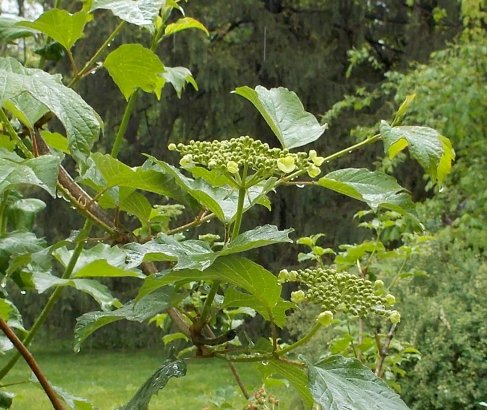This article on today’s NY Times op-ed page captures the big picture–the relationship between the local environment and the large-scale ecological system:
As you read it, think about our local environment: what human-made changes are bad for the overall environment? How can we help mitigate those changes? Will those further changes have unforeseen consequences?
And now for the close-up: it’s still raining, and here’s a picture of Viburnum trilobum (native cranberrybush viburnum) just coming into bloom.This shrub is right outside our back door:
Notice the outer ring of showy florets, which are sterile and just there for visual attraction (attraction for pollinators, not for us). The inner, fertile flowers will be tiny and fuzzy when they open, and they will have a light, subtle fragrance. The plant will attract pollinators by the score when it’s in bloom a few days from now. Those insects will in turn attract birds, seeking to feed their hungry nestlings; in the winter, more birds will eat the bright-red fruit. Contrast this in your mind with a showy nonnative viburnum, such as a Korean spicebush or an old-fashioned doublefile viburnum–you know, the kind you can buy in any garden center. The nonnative plant will be much showier, but it will not play a useful role in the ecosystem–those gorgeous, extremely fragrant flowers will not attract pollinators, and there will be no berries to feed the birds in winter.
Now think again about the NY Times op-ed piece and about the choice the scientists must make about wolves in Isle Royale National Park. On a very small scale, this is the choice you make every time you select a new shrub or decide how to care for your lawn. What will the consequences be? We don’t always know–in fact, we rarely do. But it’s important always to realize that there are consequences. It all adds up to the big picture.
Update on my herb garden: Critters have devoured every single parsley, dill, and chervil plant and most of the salad burnet. They are also eating the flower buds off downy phlox and the new shoots of most of my asters. What our local ecosystem needs is more carnivores!

Pingback: Black Haw (Viburnum prunifolum ) | Find Me A Cure